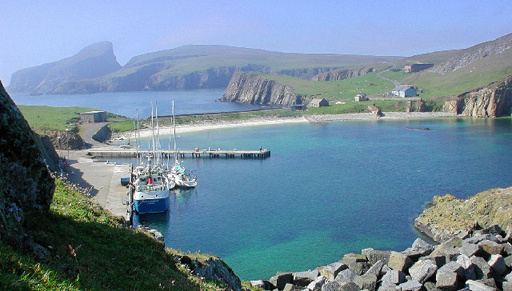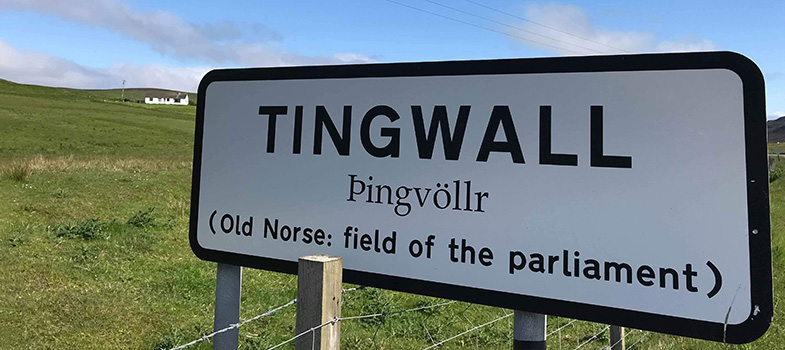10.6 Sir Walter Scott’s Fair Isle visit

Situated in between Orkney and Shetland is the island of Fair Isle. Part of Shetland, residents of Fair Isle speak of “going to Shetland” the same way as residents of Shetland speak about “going to Scotland”.
The history of Fair Isle is a chronicle of a never-ending contest for survival as successive generations of Islanders battle it out against the awesome power of nature. Consider the geographical position. To the north, twenty five miles over dangerous waters to the Shetland district of Dunrossness; to the south, a similar distance to North Ronaldsay in Orkney. Straddling the east to west and north to south shipping routes, the pillared cliffs of Fair Isle are bombarded by the tides of the Atlantic and the North Sea.
This is the opening paragraph of the book Eight Acres and a Boat: Two hundred years of crofting in Fair Isle by Jerry Eunson. Chapter Two of the book, Visitors to Fair Isle (and what they thought of us), is introduced with a few comments from the author, one being “Certain visitors pulled no punches about living conditions on the Island.” (p.11) Of the twelve visitors who have their comments shared in the chapter, Sir Walter Scott has some of the most interesting opinions, which Eunson introduces as follows:
Inspection of the Scottish Signal Stations was once the province of the Sheriffs of Scotland and Sir Walter Scott participated in such a tour in 1814. This was a period when pressure was building up for lighthouses to be built around the dangerous Scottish coast. The Shetland Times gave a report of his visit to Fair Isle, which produced, in typical Scott fashion, a remarkably detailed and perceptive survey of island life and the way of life of the inhabitants.
Here are some of Scott’s observations from Fair Isle where you find references to many of the trades and details of Scottish working life which have been discussed throughout this chapter:
In front of the little harbour is the house of the tacksman, Mr. Strong, and in view are three small assemblages of miserable huts, where the inhabitants of the Isle live. There are about thirty families and 250 in habitants upon the Fair Isle. It merits its name, as the plain upon which the hamlets are situated bears excellent barley, oats and potatoes and the rest of the Isle is beautiful pasture, excepting to the eastward, where there is a moss; equally essential to the comfort of the inhabitants, since it supplies them with peats for fuel.
The inhabitants pay Mr Strong for the possessions which they occupy under him as sub-tenants and cultivate the Isle in their own way i.e. by digging instead of ploughing (though the ground is quite open and free from rocks, and they have several score of ponies), and by raising alternate crops of barley, oats and potatoes; the first and last are admirably good. They rather over-manure their crops; the possessions lie runrig; that is by alternate ridges, and the outfield or pasture ground is possessed as common to all their cows and ponies.
The manners of these islanders seem primitive and simple and they are sober, good-humoured and friendly – but ‘jimp’ honest. Their comforts are, of course, much dependent on ‘their master’s pleasure’, for so they call Mr. Strong; but they gave him the highest character for kindness and liberty and prayed to God he might long be their ruler.
Stevenson and Duff went to inspect the remains or vestiges of a Danish lighthouse upon a distant hill called, as usual, the Ward or Ward hill and returned with specimens of copper ore. Hamilton went down to catch fish for our dinner and see it properly cooked and I went to see two remarkable indentures in the coast called ‘Rivas’, perhaps from their being rifted or ‘riven’. They are exactly like the Bullar of Buchan, the sea rolling into a large open basin within the land through a natural archway.
The clergyman of Dunrossness in Zetland visits these poor people once a year, for a week or two during the summer. In winter this is impossible and even the summer visit is occasionally interrupted for two years. Marriages and baptisms are performed, as one Isles-man told me ‘by the slump’, and one of the children was old enough to tell the clergyman who sprinkled him with water: ‘The De’il be in your fingers’. Last time four couples were married and sixteen children baptised. The schoolmaster reads a portion of Scripture in the Church each Sunday when the clergyman is absent, but the present man is unfit for this part of his duty.
Fair Isle inhabitants are a good-looking race more like Zetlanders than Orkneymen. Evenson and other names of a Norwegian or Danish derivation attest their Scandanavian descent. Mr. Strong gave me a curious old chair belonging to Quendale, a former owner of Fair Isle. I will have it refitted for Abbotsford.
Activity 9
Now go back over Scott’s account of his visit to the Fair Isle and take a note of the trades and details of Scottish working life he mentions. Pay particular attention to the work that is related to producing food.
Once you have listed the items related to food and eating, test yourself and translate these words from Scott’s text into Scots language.
Answer
Here is our list of trades and working life on the Fair Isle. Your list might look different:
- Agriculture growing barley oats and potatoes
- Fishing
- Farming breeding cows for milk and meat production, and ponies as work horses
- Peat harvesting for fuel to heat houses
- Clergyman comes to visit once a year
- Teacher takes on clergyman’s duties on Sundays for the rest of the time.
And here is our suggestion for the translation of the key items in the list:
- aittis, bere, tatties
- fish
- coo and powiny, or pounnie, or poynie, or pawnie.
The final word should, in our opinion, be from Jerry Eunson, who closes Sir Walter Scott’s unit with these comments:
Scott spent but a few hours on the Island before continuing his journey south and his assessment of Fair Isle contains both a romantic gullibility of the surroundings and the intellectual arrogance and ignorance of the ‘incomer’.
In particular, the tacksman, James Strong, would have set out to impress his esteemed visitors and had succeeded. Practically everyone on the Island would agree that Strong was a tyrant. Much of the poverty was the direct result of his pitiless control of the lives of the local population.
He had it both ways, controlling both demand and supply. On the one hand, he determined how much the Islanders would receive for their fish, hosiery and other products. On the other, he set the prices for the limited but essential range of foodstuffs and materials at his shop. No competitors were permitted on the island, either as buyers or sellers. The Fair Islanders were never out of his debt.
The environment and landscapes of Shetland may contain features which make it distinct from both Orkney as well as the Scottish Borders at the furthest edge of Scotland - but the people of Shetland, together with those of Orkney, Ayrshire and the furthest south of the country all share a common history within the world of work, which, for the majority of the people, is that for generations they have had to struggle in terrible conditions against poverty.
Those in the deepest poverty were generally those who had to work in the harshest and darkest of conditions, getting little to no support, consideration or even wages from the various lairds, tacksmen and far away politicians and governments who could have their say over the future of the people - and regularly would have their say, making decisions that often put an end to both the community and a wealth of the language used there.
10.5 Mining in Scotland
